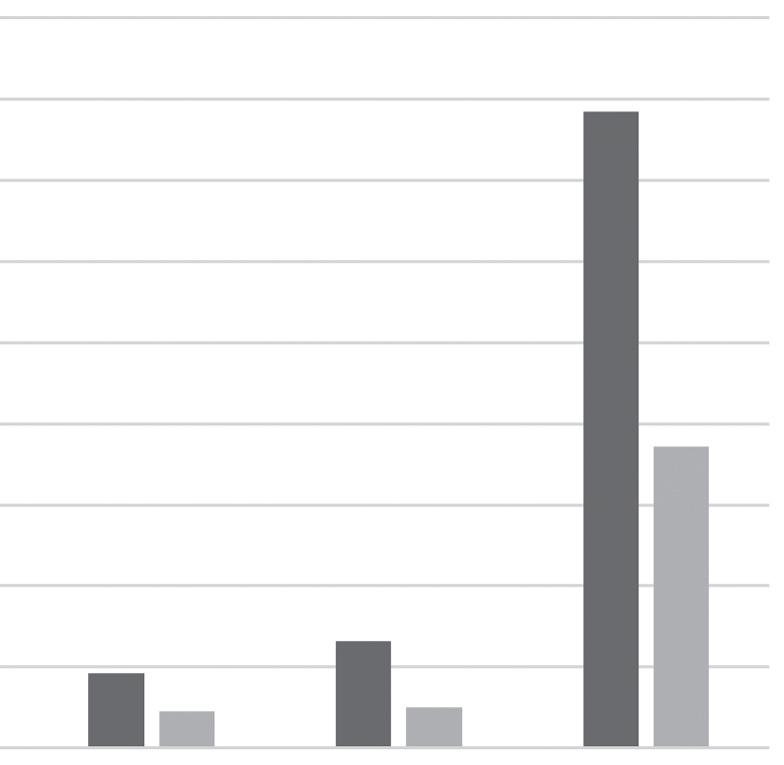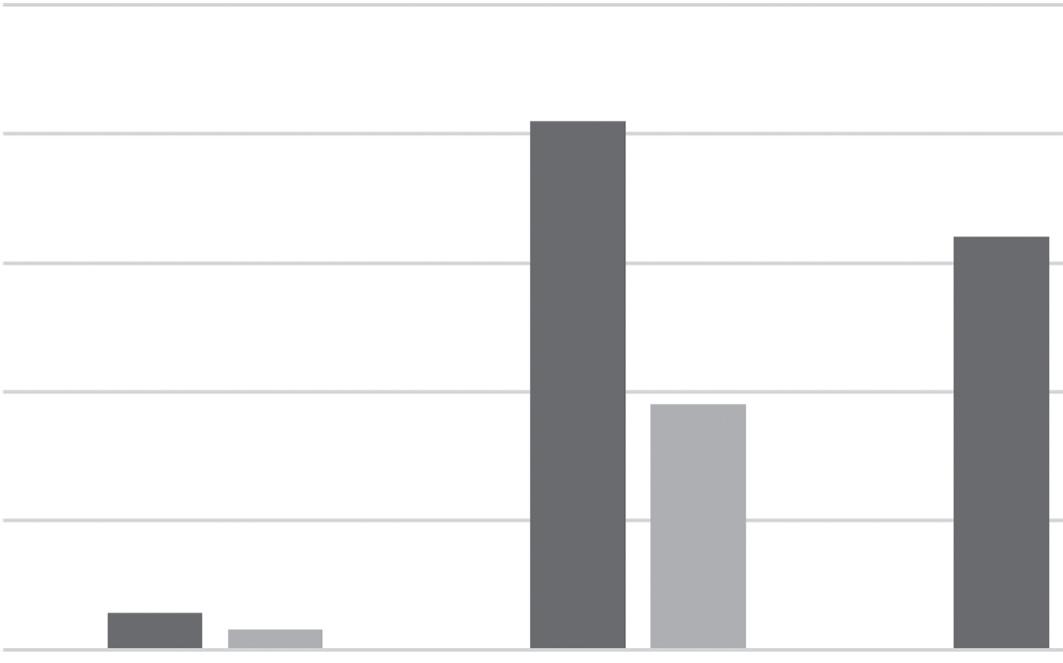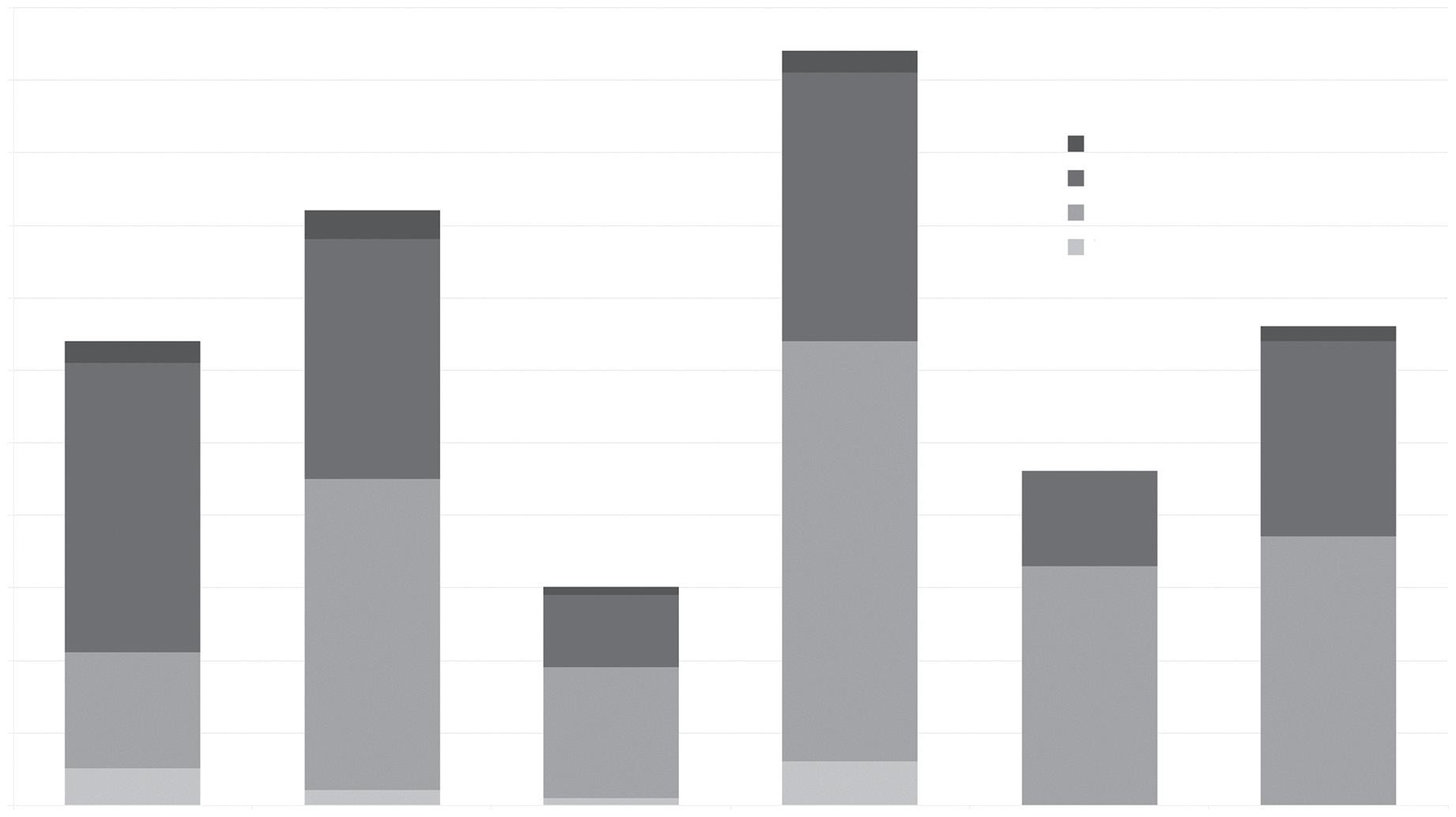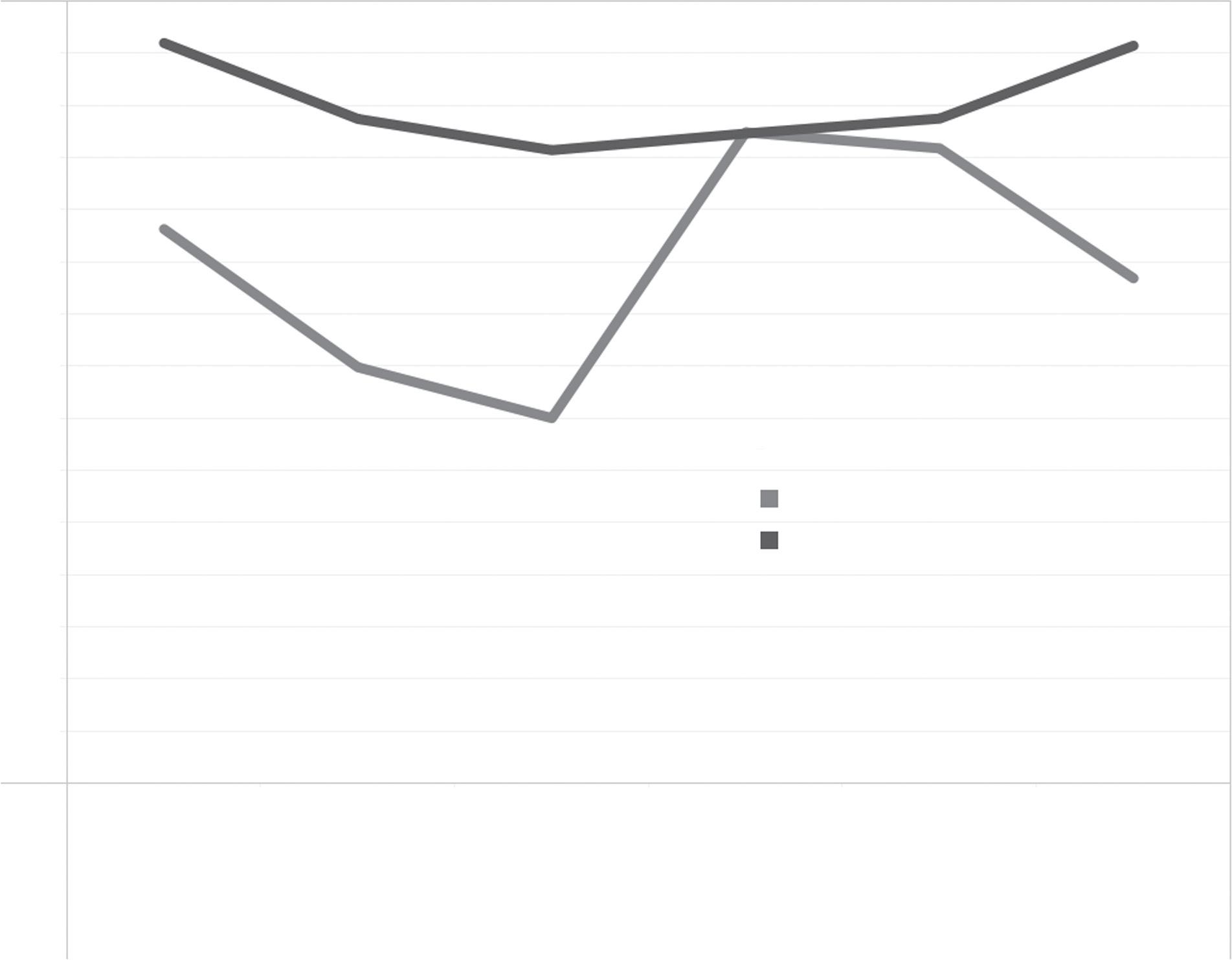Dying by the Sword: The Militarization of
US Foreign Policy Monica Duffy Toft
Visit to download the full and correct content document: https://ebookmass.com/product/dying-by-the-sword-the-militarization-of-us-foreign-pol icy-monica-duffy-toft/
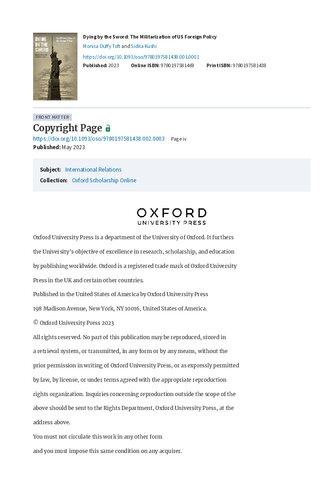
More products digital (pdf, epub, mobi) instant download maybe you interests ...
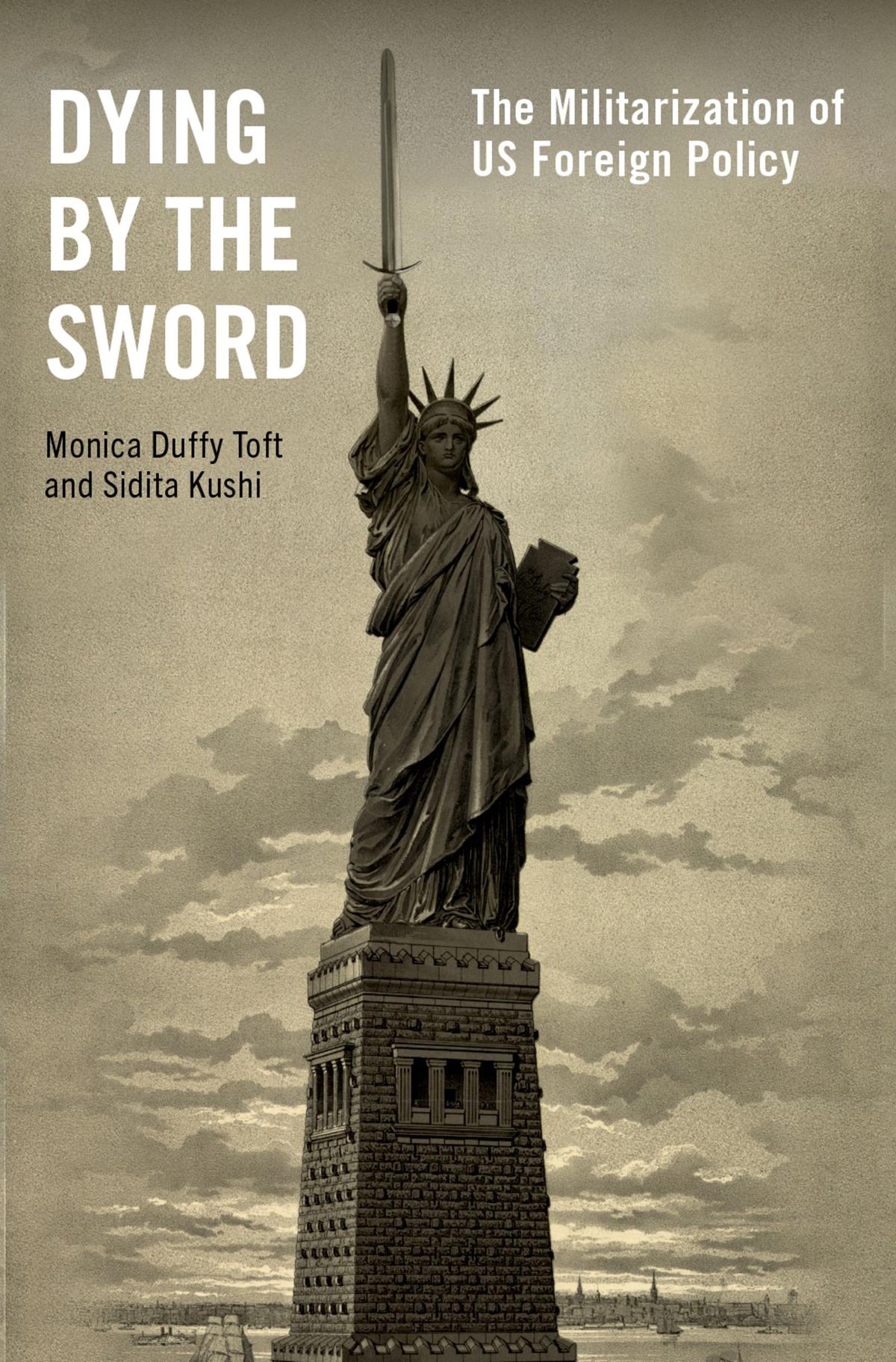
Dying
by
the Sword Monica Duffy Toft
https://ebookmass.com/product/dying-by-the-sword-monica-duffytoft/

Human Rights, Imperialism, and Corruption in US Foreign Policy Ilia Xypolia
https://ebookmass.com/product/human-rights-imperialism-andcorruption-in-us-foreign-policy-ilia-xypolia/

When Love Breaks Us Monica Arya
https://ebookmass.com/product/when-love-breaks-us-monica-arya/

Defending frenemies : alliances, politics, and nuclear nonproliferation in US foreign policy Taliaferro
https://ebookmass.com/product/defending-frenemies-alliancespolitics-and-nuclear-nonproliferation-in-us-foreign-policytaliaferro/

The Psychology of Foreign Policy 1st Edition Christer Pursiainen
https://ebookmass.com/product/the-psychology-of-foreignpolicy-1st-edition-christer-pursiainen/

Human Rights, Imperialism, And Corruption In US Foreign Policy 1st Edition Ilia Xypolia
https://ebookmass.com/product/human-rights-imperialism-andcorruption-in-us-foreign-policy-1st-edition-ilia-xypolia/

Bipartisanship and US Foreign Policy: Cooperation in a Polarized Age 6th Edition Jordan Tama
https://ebookmass.com/product/bipartisanship-and-us-foreignpolicy-cooperation-in-a-polarized-age-6th-edition-jordan-tama/

U.S. Foreign Policy: The Paradox of World Power Fifth Edition – Ebook PDF Version
https://ebookmass.com/product/u-s-foreign-policy-the-paradox-ofworld-power-fifth-edition-ebook-pdf-version/

Populist Foreign Policy: Regional Perspectives of Populism in the International Scene Philip Giurlando
https://ebookmass.com/product/populist-foreign-policy-regionalperspectives-of-populism-in-the-international-scene-philipgiurlando/
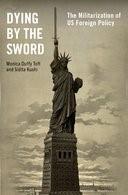
FRONTMATTER
DyingbytheSword:TheMilitarizationofUSForeignPolicy
MonicaDu�yTo�andSiditaKushi
https://doiorg/101093/oso/97801975814380010001
Published:2023 OnlineISBN:9780197581469 PrintISBN:9780197581438
CopyrightPage
https://doi.org/10.1093/oso/9780197581438.002.0003 Pageiv
Published:May2023
Subject: InternationalRelations Collection: OxfordScholarshipOnline

OxfordUniversityPressisadepartmentoftheUniversityofOxford Itfurthers theUniversity’sobjectiveofexcellenceinresearch,scholarship,andeducation bypublishingworldwide OxfordisaregisteredtrademarkofOxfordUniversity PressintheUKandcertainothercountries.
PublishedintheUnitedStatesofAmericabyOxfordUniversityPress 198MadisonAvenue,NewYork,NY10016,UnitedStatesofAmerica. ©OxfordUniversityPress2023
Allrightsreserved.Nopartofthispublicationmaybereproduced,storedin aretrievalsystem,ortransmitted,inanyformorbyanymeans,withoutthe priorpermissioninwritingofOxfordUniversityPress,orasexpresslypermitted bylaw,bylicense,orundertermsagreedwiththeappropriatereproduction rightsorganization Inquiriesconcerningreproductionoutsidethescopeofthe aboveshouldbesenttotheRightsDepartment,OxfordUniversityPress,atthe addressabove
Youmustnotcirculatethisworkinanyotherform andyoumustimposethissameconditiononanyacquirer
LibraryofCongressCataloging-in-PublicationData
Names:Toft,MonicaDu�y,author |Kushi,Sidita,author
Title:Dyingbythesword:themilitarizationofUSforeignpolicy/ MonicaDu�yToftandSiditaKushi
Description:NewYork,NY:OxfordUniversityPress,[2023]|
Includesindex
Identi�ers:LCCN2022058408(print)|LCCN2022058409(ebook)| ISBN9780197581438(hardback)|ISBN9780197581445(epub)
Subjects:LCSH:Intervention(Internationallaw)|Con�ictmanagement UnitedStates History | Militarism UnitedStates History |UnitedStates Foreignrelations
Classi�cation:LCCJZ6368 T632023(print)|LCCJZ6368(ebook)| DDC303.6/90973 dc23/eng/20230111
LCrecordavailableathttps://lccn loc gov/2022058408
LCebookrecordavailableathttps://lccn.loc.gov/2022058409
DOI:10 1093/oso/9780197581438 001 0001
PrintedbySheridanBooks,Inc.,UnitedStatesofAmerica

FRONTMATTER
DyingbytheSword:TheMilitarizationofUSForeignPolicy
MonicaDu�yTo�andSiditaKushi
https://doi.org/10.1093/oso/9780197581438.001.0001
Published:2023 OnlineISBN:9780197581469 PrintISBN:9780197581438
Acknowledgments
Published:May2023
Subject: InternationalRelations Collection: OxfordScholarshipOnline
Thisbookwouldnothavebeenpossiblewithoutthesteadfastworkandsupportofthewonderfulteamat theCenterforStrategicStudies(CSS)atTuftsUniversity’sFletcherSchool Thatteamincludespostdoctoral fellows,PhDfellows,andourlargeteamofresearchassistants WethankNilsHägerdal,whodirectedthe �nalyearoftheMilitaryInterventionProject(MIP)andproducedacompleteddatasetofUSmilitary interventionsfrom1776to2019,andalsocontributedtocasestudyanalysisandsummaries
WearealsogratefultopastandpresentCSSpostdoctoralfellowsKarimElkady,BenjaminDenison,Stephen Moncrief,andAroopMukharjeefortheirresearchsupportonMIP;aswellastheirinsightfulreviewsof chapterdrafts.ThanksaswelltopastandpresentCSSResearchFellowsLimaAhmad,NehaAnsari,Zoltan FeherandDavidKampf,whoeachsupportedthisbookviatheircasestudyresearchandliteraturenotes
WethankpastandpresentCSSprogramcoordinatorsAnnaRonellandPolinaBeliakovafortheirwiderange ofsupportfortheCenter’sresearchinitiatives,budgets,andvision,amongothercontributions
WeshouldaddthatintheseveralyearsofrigorousresearchittooktoproducetheMIPdatasetandcase studies,asuperbteamofresearchassistantsattheFletcherSchoolofLawandDiplomacywere instrumentalinresearchingcases,doingbackgroundhistoricalresearch,andupdatingcomponentsofour dataset.WearegratefulforourRAleadersandresearchersBryanCassella,MarioZampaglione,Dylan Farley,AndrewHogan,andEmilyKennellywhotrainedandsupervisedotherRAsondatasetcodingand entryaswellascompletedcasestudyresearchandwriting.WethanktherestofouramazingRAteamfor theirhardwork,includingourseniorRAsDanielCreamer,JacquelineFaselt,MoriahGraham,Daniel Morton,andNateDobbin,aswellasSamuelCarletta,EmilioContreras,DavidFolsom,IanFranckling, CamilleFreestone,BeckiGlawe,MichaelGradus,SamGreen,NicholasGuarnaccia,ChelseaHanlon, MadeleineHerr,GradyJacobsen,AlexKersten,AbbyKukura,JackLashendock,RachaelLew,Claire McGillem,MeaganReid,StefanShover,CarsonThal,MichaelVandergri�, andCassandraZavislak.We’re alsoverygratefulforRachelGoretsky’seditingandformattingofourmanuscriptasitreachedits�nal stage p.xii
WewouldliketothanktheCharlesKochFoundationforitsgenerousfundingofourMIPdatasetandthe manyactivitiesoftheCenterforStrategicStudies,fromwhichthisbookisderived
We’regratefulalsotoourmanuscriptreviewersfortheirinsightfulfeedback,whichmadethisbook strongerandbetter We’realsothankfulforourOxfordUniversityPresseditorDavidMcBrideforhis expertiseandsupportthrougheverystepofthisjourney;aswellasKevinEaganforhiseditorialguidance andHemalathaArumugamandSarahEbelfortheirpatientandsoundmanagementofourmanuscript
Lastly,weowesomuchtoourrespectivefamiliesfortheirloveandsupportthroughthislongand challengingjourney.MonicaDu�yToftwouldespeciallyliketothankherhusbandIvanArreguín-Toftand theirchildrenSamandIngridfortheirsupportasshestartedworkingonthisbook;andforhelpingto providethetime,patience,andspaceneededto�nishit.
SiditaKushiwouldespeciallyliketothankherparents,EdmondandShpresaKushi,fortheirabundantlove, wisdom,andsacri�ces.Theyriskeditallinaforeignlandforthesakeoftheirchildren,anditwastheir braveryandhardworkthatmadeitpossiblefortheauthortopursueherintellectualdreams SiditaKushi wouldalsoliketothankhersisterOdetaforherconstantsupportandlifelongfriendshiplikenoother. Lastly,sheisgratefulforherhusbandIliya,whopatientlyenduredtheauthor’swritingprocessand suppliedahealthydoseofdistraction.
Introduction
War and Diplomacy in US Foreign Policy
“5,000 troops to Colombia” was ominously scribbled on an innocuous yellow pad in January 2019, showing just how much contemporary US foreign policy is defined by military interventions. The note’s author was then-US National Security Advisor John Bolton, who sought to resolve the ongoing presidential crisis in Venezuela by immediately deploying American armed forces abroad.1 Diplomacy was out, a show of military force was in. Swords over wealth and words was the order of the day. With no ambassador in Venezuela since 2010, American diplomacy was handicapped from the start. While the crisis ended with no US deployment this time, Bolton’s note illustrates how readily US political leaders push for immediate military “solutions” to burgeoning international dilemmas. What is worse, these dynamics were and are not unique to Venezuela. This “force-first” mentality reverberates through most contemporary US foreign policy choices. And despite President Joseph Biden’s stated commitment to increase the State Department’s budget to reengage the world and repair our alliances, funding remains far less than that of the Department of Defense. Yes, Russia’s war in Ukraine reinforces the notion that the risk of major interstate war remains, which we do not deny. But two key questions follow: was Russia’s slowly escalating belligerency inevitable? And second, does a force-first foreign policy generally result in an escalatory spiral? If history is any guide, the devolution of diplomacy will get worse as the primacy of military statecraft continues to take pride of place.
A critical aspect of our engagement overseas is through ambassadors, who are the president’s eyes and ears on the ground in both friendly and unfriendly places. US presidents traditionally reward some generous campaign donors with political ambassadorial appointments. The percentage of such political appointees hovered around 30 percent in the past, with 70 percent of the posts still reserved for career diplomats—diplomats who possess years of hard-earned on-the-ground cultural and practical experience. Under the
Donald J. Trump administration, that trend was nearly reversed. What’s more, the Department of State lost 12 percent of its employees in the foreign affairs division under Trump, and the diplomats that remained had to fight to remain part of the policymaking process.2 Increasingly, US foreign policy is now in the hands of inexperienced political appointees in the executive branch.
While President Biden promised to “elevate diplomacy as the premier tool of our global engagement,” and “re-empower the finest diplomatic corps in the world,” it remains to be seen whether the path dependencies of American diplomacy since the year 2000 will budge, as they will also require a dramatic rebalancing of federal budgets and priorities for many years to come.3 As of February 2022, Biden has appointed 87 ambassadors, and over half of them are political appointees; continuing the trends of the Trump administration; albeit to a lesser degree.4
US diplomacy is experiencing a fundamental shift, one a long time in the making but escalating rapidly in our contemporary era. It is moving away from the era of hard-fought negotiations among career diplomats to an age of kinetic diplomacy—diplomacy by armed force, removed from the indepth local knowledge garnered by traditional diplomats. What does this shift mean for the future of US foreign policy? Can past patterns offer clues as to the evolution of kinetic diplomacy and its most urgent consequences? By tracing US foreign policy through different eras with a combination of historical narratives, theoretical perspectives, and data-driven empirical analysis, this book identifies both key trends and lessons for contemporary politics.
The Argument
Throughout its history as a global actor, the United States has taken on many roles. It evolved from a relatively isolationist state to a hesitant intervenor to a global policeman and defender of the liberal world order. But in the past two decades, it has often and quickly escalated to the use of force abroad, with strong domestic and international backlash. In survey after survey, if you ask the global public, America is seen as a bigger threat to global peace and prosperity than China and Russia (prior to Russia’s invasion of Ukraine).5 These perceptions may arise from trigger-happy US foreign policy, characterized by an overreliance on force, with minimal support for diplomatic efforts and
few consistent national strategies. Relying on military force is hardly a new means to project power abroad. Indeed, factions of more hawkish political elites often contend with more restrained voices and ideologies. In other words, the impulse to be more forceful always existed across every era of US foreign policymaking, but structural forces and historical events sometimes serve to mute or embolden this impulse.
For instance, for an entire decade after Vietnam, the US military’s reputation suffered, and few Americans trusted in the use of force abroad. After Ronald Reagan vowed to rehabilitate the US military, and after two equivocal US victories in Grenada and Panama, the US military regained its image as an effective institution, and gained the respect of US public opinion. Yet at the same time, as political scientist Ivan Arreguín-Toft has shown,6 great powers—even superpowers like the Soviet Union—were losing wars against, on paper, much weaker adversaries more often than winning them. Highly tuned to this problem, the Department of Defense adopted the Weinberger Doctrine as a hedge against joining the toll of losses in unconventional wars. It wasn’t to last, largely due to the American habit of fetishizing new technology which, along with traditional US exceptionalism, invariably appears to invalidate the hard-won lessons of past military failures.
In Humane, for example, Samuel Moyn tells the story of how the United States has succeeded in reimagining armed combat as a consistent, firstline tool of foreign policy, instead of as an imperfect tool of last resort, or as a prelude to quagmire (think Afghanistan, 2001–2022). Examining over a century of history, he reflects on how the availability of precision weaponry and the path dependencies of safeguarding the US national image led us to the contemporary era of “forever wars,” perhaps minimizing some of the violence but perpetuating US dominion globally.7 Historically, attempts to decrease the friendly costs of war (i.e., our own casualties) only serves to make war a more palatable tool of foreign policy; as in the case of the United States’ post-9/11 drone warfare programs, which present a sanitized image of modern warfare and separate that image from the everyday lives of both American citizens and policymakers.
In recent decades, domestic structures and international events strengthened the American impulse towards forcefulness to unprecedented levels. Such factors include but are not limited to the aftermath of a US “unipolar moment” in which, following the end of the containment doctrine against the Soviet Union, national interests expanded to include human rights promotion, democratization, drug interdiction, and other non-trivial
but nonvital geopolitical interests. US militarism also found fertile ground in rising defense spending even after the end of the Cold War, propelled partially by growing power of “the Iron Triangle:” the confluence of interest of congressional committees, US federal agencies, and special interest groups and defense industry lobbyists.8 In fact, according to OpenSecrets, a nonprofit that measures money flows within the Iron Triangle, between 1998 and 2021, the defense sector led by corporations such as Raytheon, Lockheed Martin, and Boeing was one of top-ranked spenders on lobbying the US government.9
Not only is the frequency of US military intervention increasing, but the level of US hostility is rising, the nature of US interventions is shifting, and its aims are escalating. In fact, our data reveal the United States hasn’t had a year without at least one newly started military intervention since 1974. According to our research, the United States has undertaken almost 400 international military interventions since 1776, with more than half of them occurring after World War II. What’s more, the United States waged 29 percent of these interventions in the post–Cold War era and they were more intense.10 With recent interventions in Afghanistan, Iraq, and Libya, as well as weaponized drone campaigns in Pakistan, Yemen, and beyond, the widespread global concern about America’s role in the world we and others have highlighted should not be surprising.
As its experience in and exit from Afghanistan attest (now standing as longest US war by far, as Figure AI.1 reveals), assessing the success of US military interventions is a fraught endeavor as well.11 On one hand, in most of its contemporary missions, the United States overwhelmed other states with its military power and won a good number of short-term victories. On the other, in these same missions, the United States often failed to achieve longterm goals: a problem known colloquially as “losing the peace.” Its lack of diplomatic engagement often inflames insurgencies and ignites civil wars in the wake of swift military victories. Therefore, worst of all, the United States is increasing its use of force abroad at a time when the resort to arms is, at a minimum, unlikely to advance US interests and, in fact, increasingly likely to prove counterproductive; such as in urban warfare and counterinsurgency operations.12
We describe current US foreign policy as kinetic diplomacy, which supplanted the traditional statecraft trifecta of diplomacy, trade and aid, and war as a last resort. As traditional diplomacy withers away and political elites gut the US Department of State, military interventions—including shadowy
special operation missions, drone strikes, and “gray zone warfare” efforts— grow at unsustainable rates; as do the quantity and quality of US adversaries.
By means of an historical and data-driven review of the dominant foreign policy trends from the nation’s founding in 1776 until today, we contend the United States has become addicted to military intervention. Each individual crisis appears to demand a military response, but a short-term respite then results in an even bigger problem later, which again seems to beg of an armed response, and so on and on: violence begets violence. Unlike the past, where force was a last resort, the United States now pursues a whack-a-mole security policy—much more reactionary than deliberate, lacking clear national strategic goals. We trace different eras of US foreign policy, marked by changing US strategic objectives. In the 1700s, the key US strategic goal was independence from Britain. The 1800s involved national expansion and the conquest of the Great Frontier, while warding off European powers. The United States emerged from relative isolation in the early 1900s to focus on the so-called war to end all wars, then shifted to defeating the Axis powers decades later. During the Cold War, the United States relied on the strategy of containment to prevent World War III, deterring a great power rival while promoting democracy, free trade, and the establishment of international institutions. By the 1990s, the United States aimed to establish itself as the leader of a New World Order through multilateral cooperation, the further enmeshment and institutionalization of Western norms, and a relatively balanced arsenal of foreign policy tools. In the post-9/11 era, US strategic goals shifted to preventive war: a global war on terror, which propelled the country down the path toward kinetic diplomacy.
Dying by the Sword dedicates a chapter to each defining era of US foreign policy, introducing historical narratives and compelling patterns from the Military Intervention Project (MIP) along the way. Each chapter highlights how the United States used and balanced primary tools of statecraft— diplomacy, trade, and war—to achieve its objectives. The book concludes with a warning that if the United States does not abandon its addiction to force-first, kinetic diplomacy, it will do permanent damage to its vital national interests; including its diplomatic corps, economic influence, and international reputation. It will be doomed to more, more costly, and counterproductive wars. And it will spell disaster for America’s domestic and international stability.
These trends matter. Policymakers and the broader public need direct knowledge and access to a clear accounting of the patterns, outcomes, and
net effects of US militarism across time. After all, the descent into kinetic diplomacy directly impacts US domestic policy. Money spent on foreign wars means money diverted away from economic development, health care, pandemic response, social welfare, education, infrastructure, job creation, and other critical domestic public goods. Beyond this, a more kinetic foreign policy prompts a higher risk of American casualties abroad, rising national deficits and debt, and deteriorating international perceptions of US behavior, which may demoralize long-time allies while increasing the quantity and quality of US adversaries. US aggression may further legitimate aggression by other international actors. For instance, the US invasion of Iraq after 9/11 decreased its international legitimacy in matters of human rights and democracy, making it more difficult to uphold international norms of nonaggression and noninterventionism across the international community at large.13 And for Russia, which continues to hold that great power status comes with privileges not available to other states, acting aggressively abroad underlines Russian claims that when it employs force abroad it is only acting as any great power—and in particular, the United States—acts. In other words, rampedup US militarism results in increased threats to the US homeland as well as to the stability of the international community and postwar world order—an “order,” it must be recalled, that was designed to permit openly hostile great powers to co-exist without risking a species-ending third world war. Kinetic diplomacy puts all that at risk.
Ultimately, this book aims to provide a concise synthesis of the entire arc of America’s intervention history, offering empirical analysis of the main trends seen in our unique and comprehensive data set on all US military interventions. Our analysis shows the United States does not need to restrain itself from engaging on the world stage fully. Rather, it must rely on a more extensive array of tools to secure its vital interests and contribute to a more peaceful world. But we also argue that the impact of decades of force-first, kinetic diplomacy comes with inertia: a cumulative effect whose most costly aspects may take years to reverse. It will take skilled and consistent leadership to undo the damage already done by a sometimes necessary, but on balance excessive, resort to violence as a default foreign policy. Moreover, it will take an educated and alert public to hold its leaders to account in how US interests are secured and US dollars are spent to secure those interests. This introduction first offers an outline of the critical turning points, debates, and tools in US grand strategy and then introduces the book’s approach, illustrating how it offers distinct contributions from previous
empirical efforts. Next, the introduction highlights the seven eras of US foreign policy, assessing the country’s strategic goals. We also show how current patterns of US foreign policy are detrimental to the future of the country and the world before providing a roadmap for subsequent chapters.
Grand Strategy and the Three Pillars of Statecraft
Generally, the United States interacts with other states in the international system through the use of force, trade, and diplomacy, institutionalized via the departments of defense, commerce, and state, respectively. Of course, there has always been a trade-off between diplomacy and war. As General James Mattis, commander of US Central Command in 2013 said in Congressional testimony, “if [Congress doesn’t] fund the State Department fully, then I need to buy more ammunition.”14 But what happens when diplomacy becomes a shell of its former self? What ensues when a grand strategy pillar the United States took for granted for centuries—diplomacy first and war as a last resort—collapses?
Unfortunately, the United States no longer balances its various tools of statecraft as it once did. Its eagerness to rely on military force escalated during the Cold War, mainly because the American public fell for the narrative of domino logic, and the image of an irrational communist enemy bent on world domination. In terms of Soviet, Chinese, and Cuban foreign policy, this narrative was not entirely false. But it wasn’t policy but the dehumanization of the ‘other’ that ultimately led to a habit of leading with armed force. If its enemies were monsters that could not be reasoned with, then why bother even attempting to sway them from their path of destruction through bargaining and diplomacy? Better to beat them into submission.
But this widely held assumption of irrationality is far removed from realities on the ground. Even the most fervent communist rebels or leaders have tangible, strategic goals, such as national independence or increasing their resource capabilities; goals the United States could have engaged through shrewd diplomacy and economic statecraft. At least during the Cold War and in the immediate post–Cold War period, this assumed irrationality mainly applied to communist leadership and was restrained by the grand strategy of containment.
The 9/11 attacks, however, shattered any lingering nuance for good. The aftermath of the terrorist attacks—attacks organized and led by
self-proclaimed religious actors undeterred even by the certainty of their own physical destruction—emboldened those political leaders who, in their bid to promote greater US military involvement, would depict enemies as irrational haters and their populations as bad people. Once this narrative takes hold, diplomacy is off the table as there is a refusal to negotiate with evil people, especially terrorists. Only brute force remains as an option. The George W. Bush administration took it a step further by identifying preventive wars as a tool of grand strategy. The logic is to kill evil, irrational enemies abroad before they have a chance to attack at home.
This is how kinetic diplomacy became enshrined in the US political psyche. Fueled by narratives of irrational, evil enemies, kinetic diplomacy grows in parallel with shrinking diplomatic capacity and bloated defense budgets, egged on by powerful interest groups within the Iron Triangle. The more force is resorted to, the more it has to be resorted to, and the United States ends up in a permanent state of war; a state of war which acts to abridge civil liberties and due process, stunts economic growth and starves infrastructure maintenance, and even suppresses gender equity (an environment of pervasive threat acts as a tax on women’s leadership and full participation in the nation’s economic, political, and social life).
To clarify, kinetic diplomacy is not the same as coercive diplomacy.15 In the case of coercive diplomacy, a state relies on a combination of diplomatic channels to threaten a costly escalation unless the target countries comply.16 In kinetic diplomacy, a state immediately turns to predominantly stealthy military resources, such as drone warfare, special operations, and covert missions, to violently coerce a rival in an attempt to prevent a costly escalation. In a word: it attempts to achieve its goals by killing. Unfortunately, even the best trained special operations forces can only accomplish so much without the aid of traditional diplomatic support, economic levers, or better intelligence. And intelligence comes in two main types: short-term, battlefield and operational intelligence; and long-term, cultural, linguistic, and historical intelligence. Military might only goes so far without both types of intelligence, and without the other basic tools of modern statecraft.
Hampered by an overreliance on force, the United States is also struggling to craft a new grand strategy that will help guide its national security and foreign policies into the future. While the concept of grand strategy is naturally fluid and frequently a subject of academic debate, we can generally define it as the highest-order vision that molds a state’s foreign policy ends and means and as the overarching approach to national security—one that applies both
to wartime and peacetime.17 Thus, grand strategy demands the prioritization of interests, consensus formation on threats and opportunities, and contingency plans for changing circumstances. Moreover, grand strategy must leverage and organize all instruments of statecraft, such as war, trade, aid, and diplomacy, toward the pursuit of national interest and power.
As subsequent chapters illustrate, the United States relied on at least one or two grand strategic visions across different eras to formulate and achieve critical objectives. If we consider the contemporary era, there are competing visions for what the United States should try to achieve, from isolation to deep engagement, as outlined in Table I.1.
These contemporary debates and schools of thought on what America’s strategy is or should be focus on the country’s proper role in the international system in the wake of the Soviet Union’s collapse. Scholars and policymakers alike continue to debate whether the United States should remain leader of the “free” world, continue some sort of engagement but in a more restrained manner, or pull back from existing commitments and focus its energy at home (isolationism).
Modern-day strategies differ from those pursued during the Cold War, which featured the United States counterbalancing the Soviet Union. It was a robust Department of State that shepherded the United States to its superpower status in the post–World War II era. Under the guidance of personalities such as George C. Marshall, the secretary of state beginning in 1947, the United States continued to safeguard the vital connection between diplomatic power and military effectiveness. It reinforced the expectation that civilian officials always outranked generals in policy decisions, as witnessed when President Harry S. Truman fired General Douglas MacArthur over MacArthur’s insistence on continuing to seek a decisive victory in North Korea in 1951, despite contradictory administrative directives.18
Thanks to another diplomat, George F. Kennan, deputy chief of mission in Moscow, the United States successfully navigated the Cold War era as well. In his “Long Telegram” and subsequent “X Article” in Foreign Affairs, Kennan helped temper US military responses to its primary threat, the Soviet Union.19 Kennan declared that an all-out military option would fail because the United States had already demobilized in Europe while a large number of Soviet troops remained within rapid striking distance of Paris and the rest of Western Europe. Most importantly, Kennan reminded the American public and its elites that while the Soviet Union held to an expansionist revolutionary ideology, it still behaved in pragmatic, self-interested ways


